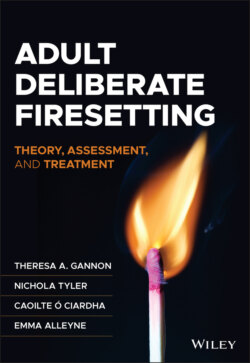Читать книгу Adult Deliberate Firesetting - Theresa A. Gannon - Страница 20
Characteristics of Adults Who Set Fires Sociodemographic Findings
ОглавлениеMen appear more likely to engage in deliberate firesetting than females. Examination of a nationally representative US sample including participants self-reporting lifetime firesetting (including juvenile firesetting) suggested that for every woman reporting deliberate firesetting, there were almost five men (the National Epidemiologic Survey on Alcohol and Related Conditions [NESARC] dataset; Blanco et al., 2010; Hoertel et al., 2011; Vaughn et al., 2010). A study of all individuals convicted of arson in Sweden over a 12-year period indicated that approximately four men were convicted of arson for every woman (Anwar et al., 2011). The gender difference was slightly larger in a study of all individuals convicted of arson in a 9-year period in a single Australian state, with over six men convicted for every woman (Ducat et al., 2017). Dickens and Sugarman (2012) suggested that women may be more likely to be diverted from the criminal justice system or referred to psychiatric services. Some psychiatric samples appear to evidence this latter point. For example, Enayati et al. (2008) reported three men for every woman in their study of all individuals convicted of arson and sent for psychiatric assessment over a four-year period in Sweden. While men appear to set deliberate fires at a higher rate than women, women appear to account for a higher proportion of those convicted of firesetting than they do of people convicted of other offences (Ducat et al., 2013a). To date, research appears only to have examined firesetting and gender using a male–female dichotomy.
There is little clear evidence that ethnicity meaningfully intersects with whether people set fires. Using nationally representative self-reported US data, lifetime firesetting was reported less frequently by Black, Hispanic, and Asian participants than by non-Hispanic white participants (Blanco et al., 2010). However, this dataset (the NESARC study; see also Hoertel et al., 2011; Vaughn et al., 2010) is one of few sources of prevalence statistics using nationally representative data. Another US representative study of adolescents also indicated that self-reported firesetting was more common among white participants than participants of other ethnicities (Chen et al., 2003). However, the dearth of comparable non-US literature presents a challenge in generalising any ethnicity difference in self-reported firesetting prevalence to other jurisdictions. Dickens and Sugarman (2012) concluded that the ethnicity of individuals who set fires in existing clinical studies is broadly comparable to the population from which they are drawn. For example, Gannon (2010) suggested that women who set fires were characterised by white ethnicity. However, this was consistent with individuals apprehended for other offences in the small sample studies she relied on and likely matched the general population in those jurisdictions.
The population of apprehended adults who set fires appear to be more likely than non–justice-involved individuals to experience greater socioeconomic disadvantage and have lower educational attainment, as well as lower rates of skilled employment (for a review, see Gannon & Pina, 2010). Based on a small number of studies that compared people who set fires to other apprehended individuals, individuals with a history of firesetting appear to have lower attainment in terms of education (Räsänen et al., 1995) and employment (Ducat et al., 2013a; Räsänen et al., 1995). However, when we look at the NESARC data on self-reported firesetting in the US population, it appears that individuals who had set fires were not characterised by sociodemographic differences compared with the wider community (Blanco et al., 2010; Vaughn et al., 2010). Split by gender (Hoertel et al., 2011), these same data suggest that men who set fires had higher levels of education on average than those who had not set fires. Across three UK studies, Barrowcliffe and Gannon (2015, 2016; Gannon & Barrowcliffe, 2012) found no clear evidence of sociodemographic differences between individuals reporting firesetting for which they had not been apprehended and people who did not report firesetting.
The current literature is very limited in scope in terms of its examination of the sociodemographic characteristics of adults who set fires. However, based on what is currently available, adults who set fires do not appear to differ profoundly from the rest of the population apart from a clear predominance of men, a potentially higher prevalence among white individuals, and lower socio-economic status and educational attainment. Further research is needed that compares appropriate samples of adults who set fires to other justice involved individuals on basic demographic variables.
